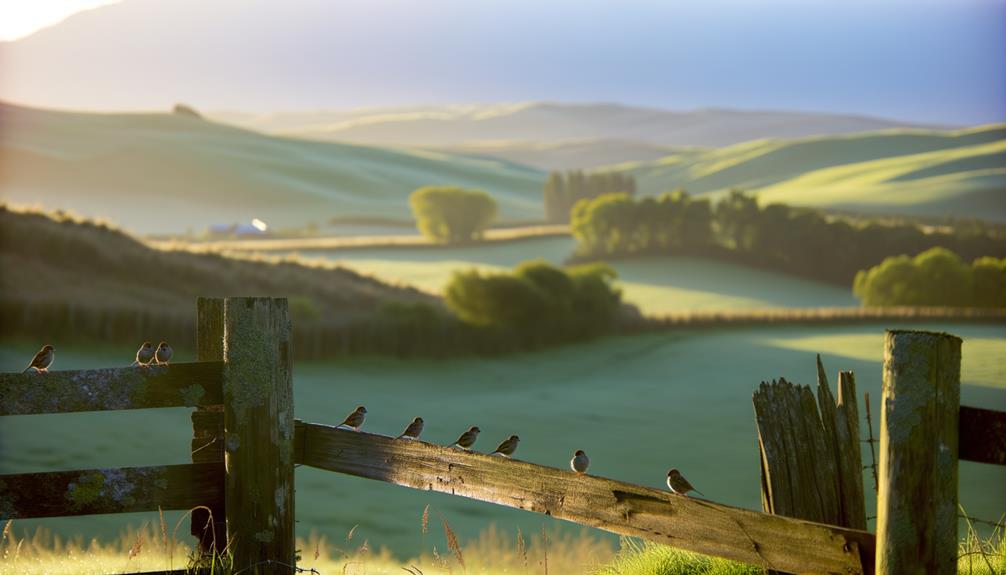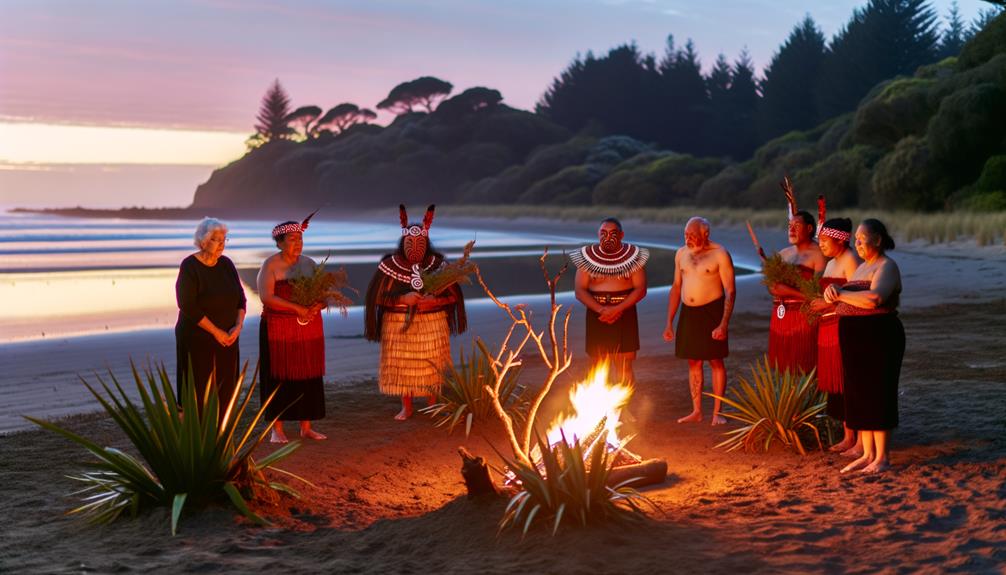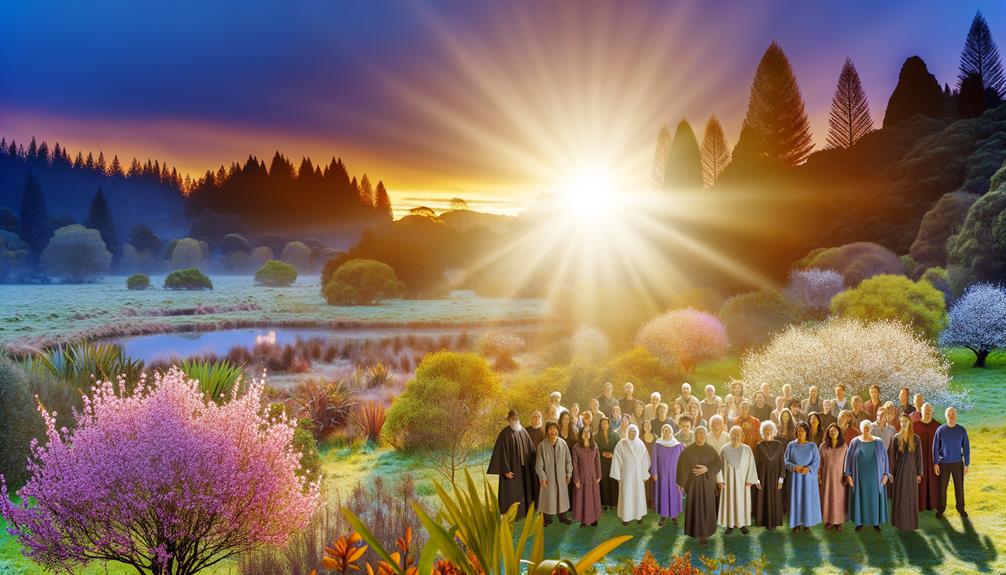What Would Meeting at Sparrows Mean in New Zealand?
In 19th-century New Zealand, 'meeting at sparrows' described dawn gatherings focused on farming coordination, community decisions, and mutual support. These early morning meetings fostered unity and a sense of belonging, intertwining daily routines with communal rituals.
Participants discussed crop rotation, livestock management, and market prices, addressing local issues collectively. Activities often included storytelling, shared meals, and cooperative tasks, reinforcing social cohesion.
Timing was influenced by seasonal changes and sparrow activity, ensuring efficient time management and best possible participation. This communal practice radiated with cultural significance, and one could uncover fascinating depth in its roles and origins.

Key Takeaways
- Early 19th-century New Zealand dawn gatherings symbolizing unity and mutual support.
- Focused on farming coordination, community decision-making, and conflict resolution.
- Involved communal storytelling, shared meals, and cooperative tasks.
- Reflected reliance on environment and profound cultural significance.
- Adapted to seasonal variations and wildlife behavior, particularly sparrows.
Origins of the Phrase

The phrase 'meeting at sparrows' traces its origins to early 19th-century New Zealand, where it was commonly used by settlers to describe gatherings held at dawn. This term emerged from the settlers' observation of the natural world, particularly the behavior of sparrows, which are known to be active at first light.
These early risers would often use the quiet and stillness of dawn to convene for various purposes, ranging from strategic planning to communal activities. The phrase encapsulates both a time of day and a communal spirit, reflecting the settlers' reliance on and connection to their environment.
Typical Scenarios
Early morning gatherings in 19th-century New Zealand often centered around practical tasks such as farming coordination, community decision-making, and sharing news, reflecting the settlers' need for efficient use of daylight hours.
Farmers would meet to discuss crop rotation, livestock management, and weather predictions. These meetings also served as a platform for community leaders to address local issues, from infrastructure projects to conflict resolution.
Additionally, early risers would exchange crucial information on market prices and trade opportunities. The structured nature of these gatherings ensured that every participant contributed to the collective welfare.
Observations suggest that such gatherings were instrumental in fostering a sense of community and collective responsibility, essential for the survival and prosperity of early New Zealand settlements.
Cultural Significance

Gatherings at sparrows in 19th-century New Zealand held profound cultural significance, intertwining daily routines with communal rituals that reinforced social bonds and collective identity.
These early-morning meetups were more than practical necessities; they served as crucial ceremonies where information was exchanged and communal decisions were made.
Observationally, such gatherings facilitated the transfer of oral traditions, ensuring the preservation of shared histories and cultural knowledge.
The collective act of meeting at dawn also symbolized unity and mutual support, fostering a sense of belonging among participants.
These assemblies underscored the interdependence of community members and played a pivotal role in maintaining social cohesion.
Essentially, meeting at sparrows became a cornerstone of cultural continuity and communal strength in 19th-century New Zealand.
Early Bird Activities
Participants at these dawn meetings often engaged in a variety of early bird activities, including communal storytelling, shared meals, and cooperative tasks that reinforced social cohesion and practical interdependence.
Observations reveal that communal storytelling served as a mechanism for cultural transmission, where elders imparted wisdom and historical narratives to younger generations.
Shared meals provided not just nourishment but also a setting for bonding, with traditional foods often emphasizing local produce and resources.
Cooperative tasks, such as gathering firewood or preparing communal spaces, fostered a sense of unity and mutual support.
These activities collectively facilitated a robust community structure, highlighting the intricate balance between cultural practices and the practical necessities of daily life.
The early morning environment, quiet and undisturbed, proved ideal for such engagements.
Seasonal Variations

Seasonal variations greatly influence the timing of sparrow meetings in New Zealand, primarily due to shifts in weather patterns and daylight hours.
Observations indicate that cooler temperatures and shorter days in winter reduce sparrow activity, while warmer temperatures and extended daylight in summer enhance their interactions.
Additionally, changes in wildlife behavior, such as migration and breeding cycles, further impact sparrow meeting habits across different seasons.
Weather Impact on Timing
Influenced by New Zealand's distinct seasonal variations, the timing of sparrow meetings shifts markedly with changes in weather patterns.
During the warm and wet summers, sparrows are more active early in the mornings, taking advantage of cooler temperatures before the midday heat. Conversely, in the cold and often frosty winters, their activity is noticeably delayed, aligning with the gradual warming of the day.
Spring and autumn, shifting periods, see a more moderate adjustment in their meeting times, reflecting fluctuating temperatures and precipitation.
Rainy weather, regardless of season, generally postpones gatherings as sparrows seek shelter.
As a result, New Zealand's variable climate intricately dictates the timing of these avian assemblies, ensuring sparrows adapt to optimize their daily routines efficiently.
Daylight Hours Shift
The shift in daylight hours throughout the year profoundly impacts sparrows' meeting behaviors, as these birds adjust their activities to align with the changing availability of natural light. During longer summer days, sparrows extend their foraging and social interactions, while shorter winter days compress their active periods. This adaptation ensures optimal use of daylight for essential tasks.
Key adjustments include:
- Foraging times: Sparrows start and end foraging earlier in winter.
- Roosting schedules: Extended daylight in summer delays roosting times.
- Breeding activities: Longer daylight hours in spring and summer enhance breeding success.
- Migration patterns: Shifts in daylight influence migratory departure and arrival times.
These behavioral changes showcase sparrows' remarkable ability to synchronize their life cycles with the environment's photoperiodic variations.
Wildlife Activity Changes
Winter's chill and summer's warmth trigger distinct shifts in wildlife behavior. Animals adjust their activities to thrive in each season's unique conditions. In New Zealand, the native birds' feeding and mating patterns fluctuate with these seasonal changes. During winter, shorter days and lower temperatures prompt species like the tui and bellbird to conserve energy. This leads to a reduction in foraging efforts, as they focus on high-energy food sources.
Conversely, summer's extended daylight and warmer weather lead to increased activity among the birds. They engage in more frequent feeding, mating, and nesting behaviors during this season. Marine mammals such as dolphins and whales also exhibit seasonal changes in behavior. They migrate to warmer waters in winter, only to return in summer to feed and breed.
These behavioral adaptations underscore the dynamic relationship between New Zealand's wildlife and its seasonal environment.
Practical Tips
For effective sparrow meetings in New Zealand, early morning preparation proves important, as sparrows are most active at dawn.
Efficient time management guarantees that observations are both thorough and timely.
Identifying best meeting locations, such as dense shrubbery or open fields, maximizes the likelihood of encountering different sparrow species.
Early Morning Preparation
Gathering at the break of dawn, birdwatchers meticulously prepare their gear to capture the early morning activities of New Zealand's sparrows. They understand that sparrows are most active during these hours, offering unparalleled observation opportunities. Preparation involves several key steps:
- Equipment Check: Ensuring cameras, binoculars, and notebooks are in working order.
- Clothing: Dressing in layers to adapt to fluctuating temperatures.
- Field Guide: Having a detailed bird guide handy for quick reference.
- Silent Approach: Moving quietly to avoid startling the birds.
Each step is crucial for a successful and rewarding observation session. By adhering to these practical tips, birdwatchers maximize their chances of capturing the intricate behaviors and interactions of sparrows in their natural habitat.
Efficient Time Management
To make sure every moment is utilized effectively, birdwatchers often create a detailed schedule that allocates specific times for setup, observation, and note-taking.
First, they designate early morning hours for setting up equipment, as this is when sparrows are most active.
Observation periods are meticulously timed to coincide with peak activity, ensuring maximum data collection.
Note-taking is interspersed between observation sessions to prevent critical information from being overlooked.
By adhering to this structured approach, birdwatchers minimize downtime and maximize productivity.
They also employ timers and alarms to keep track of each phase, ensuring smooth progress.
This methodical time management not only enhances the quality of observations but also contributes to more reliable and thorough data on sparrow behavior.
Optimal Meeting Locations
When selecting a *finest* meeting location for observing sparrows in New Zealand, birdwatchers should prioritize areas with abundant natural food sources and minimal human disturbance. *Prime* sites often include parks, wetlands, and coastal regions where sparrows thrive.
Birdwatchers should consider:
- Food Availability: Areas with diverse plant life provide seeds and insects essential for sparrows.
- Water Sources: Proximity to freshwater sources supports both sparrows and their prey.
- Safety: Locations with low human activity reduce stress and disturbances to the birds.
- Habitat Variety: A mix of open fields, shrubs, and trees offers nesting and foraging opportunities.
Conclusion
To wrap it up, the phrase 'meeting at sparrow's' in New Zealand signifies the practice of gathering at the crack of dawn, a time when the world is still sleepy-eyed. This early bird tradition reflects a cultural appreciation for seizing the day, often embraced by those keen to get a head start.
By understanding its origins, typical scenarios, and seasonal variations, one can better appreciate this charming euphemism for early morning meetings and the unique blend of practicality and cultural heritage it embodies.






